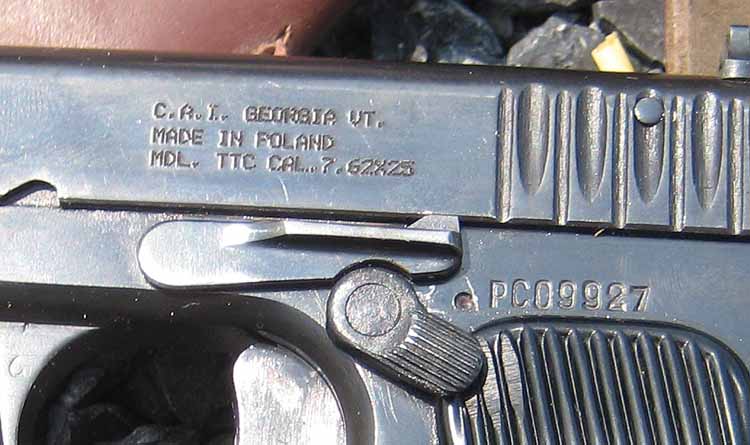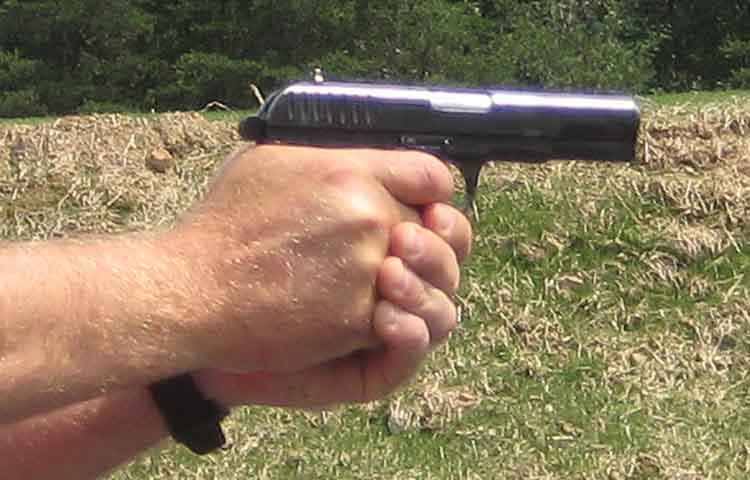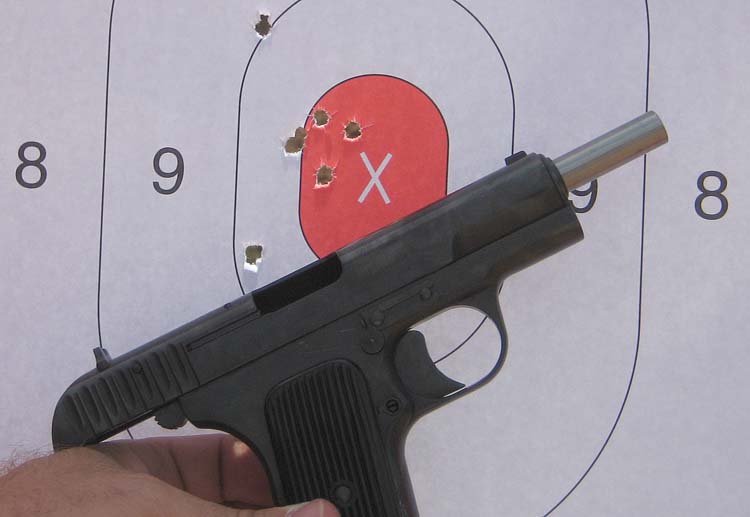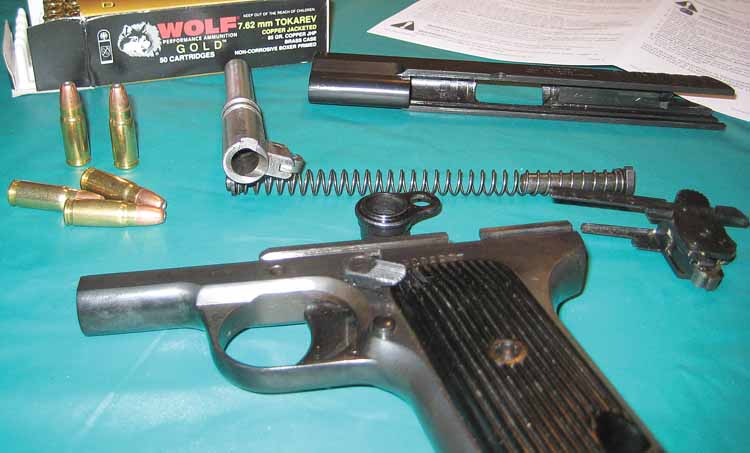Sometimes a firearm gem is found by accident. Such is the case with the Century International Arms Polish TTC semiautomatic pistol chambered in 7.62×25. It is a “Made in Poland” Tokarev TT-33. The Poles used wz48 nomenclature for their Tokarev version. Many of the Russian/Soviet designs are coming to be better appreciated since the Cold War and may be a result of the easing of import restrictions allowing for easier access; thus more familiarity as the decades have passed since the late early 1990s.

The Tokarev TT-33 was adopted in 1933 to replace the aging Nagant 1895 revolvers in Soviet service. An earlier variant, the TT-30, was originally adopted in 1930, but design changes were incorporated involving the trigger, barrel, omission of the removable backstrap, and frame to simplify production that led to the change of nomenclature to TT-33. For reference sake, the Tokarev blends exterior aesthetics of the 1903 Browning with internal workings of the Browning 1911. The pistol is a single-action, semiautomatic, recoil operated weapon patterned after Browning’s swinging link design, but modified in the Tokarev to simplify production. Essentially, the barrel and slide are locked together for a fraction of an inch during recoil allowing for the bullet to exit and pressures to drop before the empty case is extracted and ejected. The Tokarev is not a direct copy of Browning’s design and exhibits unique features of its own. The Tokarev’s trigger assembly is a modular unit and has locking lugs the full circumference of the barrel compared to only the top of the barrel in the 1911. Most semiautomatic reliability issues stem from defects in the magazine. This is addressed in the Tokarev design with cartridge feed lips machined into the receiver versus the magazine to enhance reliability and prevent damage that occurs when magazines are slammed home. The Polish TTC is fed from an eight-round single stack magazine and weighs 30 ounces with an overall length of 7.6 inches and a 4.6 inch barrel. The TTC’s width is less than that of the iconic 1911. Grip width is often commented on as being important for carryability and allowing for people with smaller hands to hold comfortably.

The Tokarev was the issue handgun for Soviet officers during World War II though many Nagant revolvers were still in use. The Tokarev fires the bottlenecked 7.62×25 cartridge, which is very similar to the German .30 cal. Mauser Automatic 7.63×25 design. The 7.62×25 was also used with the PPSh-41 submachine gun and other weapons in the Soviet armed forces. Sources report that German troops frequently used Tokarevs picked up on the battlefield. The purported interchangeability between the Soviet and German rounds further encouraged this practice. This is cautioned against since the Soviet 7.62×25 cartridge is loaded to higher pressures compared to the German round. The Tokarev’s proven ability to function under the harsh conditions of the Eastern Front was appreciated then by soldiers on both sides and now by collectors.

Ballistics are eye opening with 85-90gr bullets accelerated to 1,300+fps. The round had a reputation for potency compared to other contemporary pistol cartridges of its era and even now is capable of penetrating modern soft body armor due to its high velocity. The Tokarev’s reputation for reliability, accuracy, and lethality was proven in the greatest land conflict of the 20th Century. The Tokarev stayed in service with the Soviets until 1952 when it was officially replaced by the Makorav. The Tokarev could still be found in use with Soviet armed forces in the 1960s and Soviet Police into the 1970s. It is still in service with North Korea and China. Versions of the Tokarev were manufactured in Poland, China, Yugoslavia, Hungary, Romania, North Korea, and Egypt.
Two of the most common complaints of the original design were the lack of manual safety and grip angle. The Polish Tokarev version imported by Century has a manual thumb safety retrofitted on the frame behind the trigger to satisfy import regulations. The installed safety is a simple trigger block and is done in a fashion better than most safety add-on modifications that can be found on various other versions of Tokarev imports. Grip angle, while different than a 1911 or Glock, was not problematic during testing and evaluation. The only grip issue detected was the tendency for the hammer/slide to come into light contact with webbing around the thumb of the firing hand. This was only noticed after shooting several magazines and was remedied with a shooting glove. Importantly, the Polish Tokarev’s functionality was not compromised. The TTC was put thru the same regimen of testing as any other handguns evaluated. Century includes two magazines with the TTC and a leather holster with chest strap that also allows for spare magazine to be carried. Recoil/muzzle blast was as expected with any handgun sending rounds downrange at 1,350+fps.

. Multiple range visits over several months taking advantage of inexpensive surplus ammunition and affordable Wolf Ammunition 85gr 7.62×25 in both FMJ and JHP configurations produced no malfunctions with over 900 rounds fired. The Tokarev seemed to always find its way to the range no matter what was being tested with a few magazines fired with it. The inexpensive surplus ammunition supply is a major factor in the upsurge of popularity with the Polish TTC handguns. Solid reliability and surprising accuracy only reinforces this trend as word is spread about what is being received for well under $300.
The Polish TTC handled numerous runs through handgun courses designed for competitors using more modern pistols without an issue. Holsters designed to handle a 1911 served to carry the TTC during range visits. This worked as long as holsters were not custom or form fitted for the 1911 profile. The TTC’s magazines were not drop free, but once this was determined reloads went smoothly. The basic U-notch rear and small, narrow bladed front sight gave a decent sight picture as plate racks, steel poppers, and paper silhouette targets were engaged. The narrow front blade proved an asset in longer range shooting as daylight was still present on either side of the front sight in the rear notch allowing for a way to gauge hold better than the three-dot configurations commonly found on more modern handguns. Accuracy was impressive both in terms of group size and effective engagement distances. A steady two-handed hold combined with slow fire produced constant hits on steel popper targets at 50 yards. This is a combination of flat shooting ballistics and solid design and construction.
Take-down of the wz48/TTC is very similar to anyone familiar with a bushing barreled 1911 barrel design. Cleaning was a simple matter with no idiosyncrasies. The Century Arms TTC proved a pleasant surprise along with the potency of the 7.62×25 cartridge. Everyone with an interest in owning an operating piece of history is encouraged to try a Century Arms TTC offering for themselves.

Sites of Interest
Century International Arms
430 South Congress Ave. Suite 1
Delray Beach, FL 33445
(800) 527-1252
www.centuryarms.com
Wolf Ammunition
PO Box 757
Placentia, CA 92871
(888) 757-9653
www.wolfammo.com
| This article first appeared in Small Arms Review V14N7 (April 2011) |











